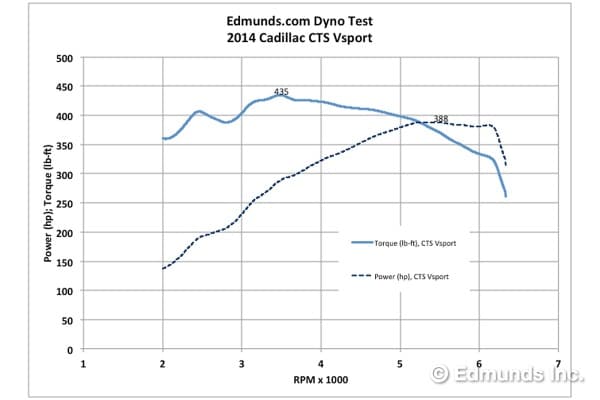Normal aspiration, your days are numbered.
The 2014 Cadillac CTS Vsport's twin-turbo, direct-injected 3.6-liter V6 is a power plant with big plans. It is slated to materialize under the hoods of several other GM models in the coming years, and with good reason. It's potent, refined, packaging-friendly and ostensibly fuel-efficient.
It's easy to warm up to the CTS Vsport's stout factory ratings of 420 horsepower and 430 pound-feet of torque. What we wanted to find out is how well this turbocharged mill maintains its output over its rev range, and how heat-sensitive it is. So we headed to Church Automotive Testing in Wilmington, California, and bolted the CTS Vsport up to its Dynapack dyno. For comparison sake, we brought along an XTS Vsport powered by the same engine turned sideways.

First, here's what we measured with the CTS Vsport:

Before we dive into the numbers, note that results from a Dynapack dyno are not directly comparable to the results of other types of dynos (Dynojet, Superflow, et al). Click here for more details. The XTS Vsport's all-wheel-drive layout precluded use of our usual Dynojet chassis dyno.
The CTS Vsport's engine (GM calls it LF3) is certainly doling out a lot of twist at very low revs. Even as low as 2,000 rpm it generates more than 350 lb-ft of torque to the hubs. Once reaching its peak of 435 lb-ft, the LF3's urge rolls off gradually on the way to its maximum 388 hp. This broad spread of power was quite repeatable from run to run, too.

By logging data from the OBD-II port we saw something intriguing: The CTS Vsport's throttle was not fully open in the midrange. This is a strategy to mitigate boost overshoot as well as manage the LF3's torque output. Knock sensor activity was relatively light, too, amounting to about 1 or 2 degrees of learned knock retard on the 91 octane we were running. What this means is that there's easily more output to be had in this twin-turbo V6.

Now, some context. Church Automotive Testing has a huge library of dyno results. The company is also something of a CTS-V specialist, so we were eager to pull up the dyno results of a stock CTS-V with its supercharged 6.2-liter LSA V8 and compare it to the CTS Vsport's boosted six.
GM rated the CTS-V at 556 hp and 551 lb-ft at the flywheel. Here's how the CTS Vsport's LF3 stacks up to a stock auto-equipped 2009 CTS-V:

The Vsport is consistently within about 80 lb-ft of the CTS-V almost everywhere in the rev range. Moreover, our results show the twin-turbo V6 is only 100 hp in arrears of the blown bent eight, rather than the anticipated 136-hp gap suggested by their flywheel ratings.
No matter what flavor of drivetrain loss you deem appropriate to apply, it appears the LF3 in the CTS Vsport is indeed something of an overachiever. Knowing that the Vsport is not a replacement for the CTS-V makes this all the more suggestive.

The car above is the Cadillac XTS Vsport, and it's powered by the same basic LF3 engine as the CTS Vsport, except turned 90 degrees. It drives all four wheels through a six-speed autobox instead of the CTS Vsport's eight-speeder, and its rated peak power drops by 10 hp to 410 hp, while rated max torque plummets 61 lb-ft to 369 lb-ft. This last bit is likely a consequence of the six-speed transmission's reduced torque-handling capability.
Onto Church Automotive Testing's Dynapack the XTS Vsport went:

The XTS Vsport managed 362 lb-ft and 349 hp to all four hubs. That's a strong peak torque showing, though it's undone to some degree by the large depression immediately following the peak. Its peak power at the hubs trails the CTS Vsport by almost 40 hp. Keep in mind there's more drivetrain loss in the XTS's all-wheel-drive layout.
It turns out that according to our scanner, the LF3 in the XTS operates with higher intake temperatures on one bank of cylinders than the other, perhaps a consequence of its transverse installation. It also experienced far more knock activity than in the CTS Vsport: We observed more than 4 degrees of learned knock retard in the XTS Vsport, which, as you can see, is doing its midrange no favors. Its throttle, too, was being trimmed here and there in order to limit mass flow and hence, output.

So the longitudinal layout of the LF3 is more powerful, sure, but also more robust in terms of repeatability and knock resistance. That's good news for the ATS-V and next-gen Camaro, both of which are expected to pack an LF3 that drives the rear wheels only.
The manufacturer provided Edmunds these vehicles for the purposes of evaluation.
